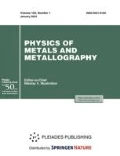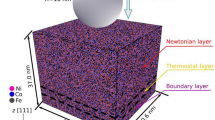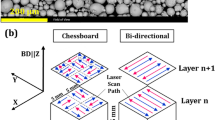Abstract—
The evolution of structure of a multicore in situ Cu-18Nb composite under high-pressure torsion (HPT) by one, three, and five anvil revolutions was investigated by scanning and transmission electron microscopy, and microhardness measurements. Thermal stability of the HPT deformed structure was studied after annealings in the 300–800°C temperature range. The combined use of repeated cold drawing and HPT made it possible to refine the structure and thereby to obtain equiaxed grains with a size of 10–30 nm, which sharply increased the microhardness (to 4800 MPa). Under the subsequent annealing the nanocrystalline structure is retained and; the microhardness remains considerably higher than that of the composite not subjected to HPT. Thus, the combination of repeated cold drawing with further high-pressure torsion provided substantial strengthening and higher thermal stability of the composite in comparison with niobium and copper nanostructured by severe plastic deformation.





Similar content being viewed by others
REFERENCES
Y. T. Zhu, T. C. Lowe, and T. G. Langdon, “Performance and applications of nanostructured materials produced by severe plastic deformation,” Scr. Mater. 51, No. 8, 825–830 (2004).
M. Kawasaki and T. G. Langdon, “Principles of superplasticity in ultrafine-grained materials,” J. Mater. Sci. 42, 1782–1796 (2007).
A. Hohenwarter, C. Kammerhofer, and R. Pippan, “The ductile to brittle transition of ultrafine-grained Armco iron: an experimental study,” J. Mater Sci. 45, 4805–4812 (2010). https://doi.org/10.1007/s10853-010-4635-9
R. Z. Valiev, Y. Estrin, Z. Horita, T. G. Langdon, M. J. Zehetbauer, and Y. T. Zhu, “Producing bulk ultrafine-grained materials by severe plastic deformation,” JOM 58, No. 4, 33–39 (2006).
Y. Estrin and A. Vinogradov, “Extreme grain refinement by severe plastic deformation: A wealth of challenging science,” Acta Mater. 61, 782–817 (2013).
A. P. Zhilyaev and T. G. Langdon, “Using high-pressure torsion for metal processing: Fundamentals and applications,” Prog. Mater. Sci. 53, 893–979 (2008).
V. P. Pilyugin, T. M. Gapontseva, T. I. Chashukhina, L. M. Voronova, L. I. Shchinova, and M. V. Degtyarev, “Evolution of the structure and hardness of nickel upon cold and low-temperature deformation under pressure,” Phys. Met. Metallogr. 105, No. 4, 409–419 (2008).
V. V. Popov, E. N. Popova, A. V. Stolbovskiy, and V. P. Pilyugin, “Thermal stability of nanocrystalline structure in niobium processed by high pressure torsion at cryogenic temperatures,” Mater. Sci. Eng., A 528, 1491–1496 (2011).
D. K. Orlova, T. I. Chashchukhina, L. M. Voronova, and M. V. Degtyarev, “Effect of temperature–strain-rate conditions of deformation on structure formation in commercially pure copper deformed in bridgman anvils,” Phys. Met. Metallogr. 116, No. 9, 951–958 (2015).
C. O. Rogachev, A. B. Rozhnov, S. A. Nikulin, O. V. Rybal’chenko, M. V. Gorshenkov, V. T. Chzhen, and S. V. Dobatkin, “Effect of torsion conditions under high pressure on the structure and strengthening of the Zr–1% Nb alloy,” Phys. Met. Metallogr. 117, No. 4, 371–377 (2016).
R. Pippan, S. Scheriau, A. Taylor, M. Hafok, A. Hohenwarter, and A. Bachmaier, “Saturation of fragmentation during severe plastic deformation,” Ann. Rev. Mater. Res. 40, 319–343 (2010).
P. V. Kuznetsov, T. V. Rakhmatulina, I. V. Belyaeva, and A. V. Korznikov, “ Energy of internal interfaces as a characteristic of the structural evolution of ultrafine-grained copper and nickel after annealing,” Phys. Met. Metallogr. 118, No. 3, 241–248 (2017).
V. V. Rybin, N. Yu. Zolotorevskii, and E. A. Ushanova, “Fragmentation of crystals upon deformation twinning and dynamic recrystallization,” Phys. Met. Metallogr. 116, No. 7, 730–744 (2015).
P. Bazarnik, Y. Huang, M. Lewandowska, and T. G. Langdon, “Enhanced grain refinement and microhardness by hybrid processing using hydrostatic extrusion and high-pressure torsion,” Mater. Sci. Eng., A 712, 513–520 (2018).
L. Krämer, S. Wurster, and R. Pippan, “Deformation behavior of Cu-composites processed by HPT,” IOP Conf. Ser.: Mater. Sci. Eng. 63, 012026 (9 pp) (2014).
V. Pantsyrny, A. Shikov, N. Khlebova, V. Drobishev, N. Kozlenkova, M. Polikarpova, N. Belyakov, O. Kukina, and V. Dmitriev, “The nanostructured high strength high conductivity Cu matrix composites with different bcc metals strengthening filaments,” IEEE Trans. Appl. Supercond. 20, No. 3, 1614–1618 (2010).
A. Shikov, V. Pantsyrnyi, A. Vorobieva, N. Khlebova, and A. Silaev, “High strength, high conductivity Cu‒Nb based conductors with nanoscaled microstructure,” Phys. C 354, No. 1–4, 410–414 (2001).
K. Edalati, T. Fujioka, and Z. Horita, “Microstructure and mechanical properties of pure Cu processed by high-pressure torsion,” Mater. Sci. Eng., A 497, 168–173 (2008).
T. I. Chashchukhina, L. M. Voronova, M. V. Degtyarev, and D. K. Pokryshkina, “Deformation and dynamic recrystallization in copper at different deformation rates in bridgman anvils,” Phys. Met. Metallogr. 111, 304–313 (2011).
A. V. Stolbovskii, V. V. Popov, E. N. Popova, and V. P. Pilyugin, “Structure, thermal stability, and state of grain boundaries of copper subjected to high-pressure torsion at cryogenic temperatures,” Bull. Russ. Acad. Sci.: Phys. 78, 1150–1159 (2014).
V. V. Popov, E. N. Popova, A. V. Stolbovskii, V. P. Pilyugin, and N. K. Arkhipova, “ Nanostructurization of Nb by high-pressure torsion in liquid nitrogen and the thermal stability of the structure obtained,” Phys. Met. Metallogr. 113, No. 3, 295–301 (2012).
T. M. Gapontseva, M. V. Degtyarev, V. P. Pilyugin, T. I. Chashchukhina, L. M. Voronova, and A. M. Patselov, “Effect of temperature of HPT deformation and the initial orientation on the structural evolution in single-crystal niobium,” Phys. Met. Metallogr. 117, No. 4, 336–347 (2016).
V. Pantsyrny, A. Shikov, A. Vorobieva, N. Khlebova, N. Kozlenkova, I. Potapenko, and M. Polikarpova, “Stability aspects of the high strength high conductivity microcomposite Cu–Nb wires properties,” IEEE Trans. Appl. Supercond. 16, No. 2, 1656–1659 (2006).
I. L. Deryagina, E. N. Popova, E. G. Valova-Zakharevskaya, and E. I. Patrakov, “Structure and thermal stability of high-strength Cu–18Nb composite depending on the degree of deformation,” Phys. Met. Metallogr. 119, No. 1, 92–102 (2018).
Y. L. Wang, K. Han, Y. Huang, and K. Y. Zhang, “Microstructure in Cu–Nb microcomposites,” Mater. Sci. Eng., A 351, 214–223 (2003).
L. Deng, K. Han, K. T. Hartwig, T. M. Siegrist, L. Dong, Z. Sun, X. Yang, and Q. Liu, “Hardness, electrical resistivity, and modeling of in situ Cu–Nb microcomposites,” J. Alloys Compd. 602, 331–338 (2014).
E. H. Ekiz, T. G. Lach, R. S. Averback, N. A. Mara, I. J. Beyerlein, M. Pouryazdan, H. Hahn, and P. Bellon, “Microstructural evolution of nanolayered Cu–Nb composites subjected to high-pressure torsion,” Acta Mater. 72, 178–191 (2014).
X. Quelennec, A. Menand, J. M. Le Breton, R. Pippan, and X. Sauvage, “Homogeneous Cu–Fe supersaturated solid solutions prepared by severe plastic deformation,” Philos. Mag. 90, No. 9, 1179–1195 (2010).
R. Lapovok, V. V. Popov, Y. Qi, A. Kosinova, A. Berner, C. Xu, E. Rabkin, R. Kulagin, J. Ivanisenko, B. Baretzky, O. V. Prokof’eva, A. N. Sapronov, D. V. Prilepo, and Y. Beygelzimer, “Architectured hybrid conductors: Aluminium with embedded copper helix,” Mater. Des. 187, 108398 (2020). https://doi.org/10.1016/j.matdes.2019.108398
Y. Qi, A. Kosinova, E. Lakin, V. V. Jr. Popov, E. Rabkin, and R. Lapovok, “Effect of SPD processing on the strength and conductivity of AA6061 alloy,” Adv. Eng. Mater. 21, 1801370 (2019). https://doi.org/10.1002/adem.201801370
A. Vorhauer, S. Scheriau, and R. Pippan, “In-situ annealing of severe plastic-deformed OFHC copper,” Metall. Mater. Trans. A 39, 908–918 (2008).
V. V. Popov, A. V. Stolbovsky, E. N. Popova, and V. P. Pilyugin, “Structure and thermal stability of Cu after severe plastic deformation,” Defect Diffus. Forum 297–301, 1312–1321 (2010).
M. V. Degtyarev, L. M. Voronova, T. I. Chashchukhina, D. V. Shinyavskii, and V. I. Levit, “Recrystallization of submicrocrystalline niobium upon heating above and below the temperature of thermally activated nucleation,” Phys. Met. Metallogr. 117, No. 11, 1111–1118 (2016).
V. V. Popov, E. N. Popova, A. V. Stolbovsky, and V. P. Pilyugin, “The structure of Nb obtained by severe plastic deformation and its thermal stability,” Mater. Sci. Forum 667–669, 409–414 (2011).
V. V. Popov, E. N. Popova, and A. V. Stolbovskiy, “Nanostructuring Nb by various techniques of severe plastic deformation,” Mater. Sci. Eng., A 539, 22–29 (2012).
H. R. Z. Sandim, M. J. R. Sandim, H. H. Bernardi, J. F. C. Lins, and D. Raabe, “Annealing effects on the microstructure and texture of a multifilamentary Cu‒Nb composite wire,” Scr. Mater. 51, 1099–1104 (2004).
L. Deng, B. Wang, K. Han, R. Niu, H. Xiang, K. T. Hartwig, and X. Yang, “Response of microstructure to annealing in in situ Cu–Nb microcomposite,” J. Mater. Sci. 54, 840–850 (2019).
ACKNOWLEDGMENTS
The authors are grateful to A.V. Stolbovskii for carrying out the HPT processing.
Funding
The studies were carried out using the equipment of the Center of Collaborative Access, Institute of Metal Physics, Ural Branch, Russian Academy of Sciences. The work was performed under the state task of the Ministry of Science and Higher Education of the Russian Federation (theme “Davlenie Pressure”, no. АААА-А18-118020190104-3).
Author information
Authors and Affiliations
Corresponding author
Additional information
Translated by O. Golosova
Rights and permissions
About this article
Cite this article
Popova, E.N., Deryagina, I.L. Evolution of Structure of Cu–Nb Composite under High-Pressure Torsion and Subsequent Annealing. Phys. Metals Metallogr. 121, 1182–1187 (2020). https://doi.org/10.1134/S0031918X20120091
Received:
Revised:
Accepted:
Published:
Issue Date:
DOI: https://doi.org/10.1134/S0031918X20120091




